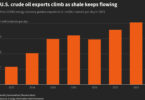ANKARA (AA): Global gold demand rose by 4 percent in 2018, according to a report by World Gold Council.
The report released on Thursday said global gold demand reached 4,345.1 tons last year, up 185.2 tons year-on-year.
“The annual increase was driven by a multi-decade high in central bank buying and accelerated investment in bars and coins during the second half of the year.
“While annual inflows into exchange-traded funds were down 67 percent in 2018, demand was boosted in the final quarter by inflows of 112.4 tons,” the council said.
Council’s figures revealed that central banks added 651.5 tons to official gold reserves in 2018 with a 74-percent annual hike, marking the highest central bank buying in 50 years.
The reports said central banks of Russia, Turkey and Kazakhstan remained key buyers throughout the year.
“Russia, which is de-dollarizing its reserves, bought, 274.3 tons in 2018, funded by the almost total sale of its US Treasuries portfolio,” it said.
“This is the highest level of annual net purchases on record and the fourth consecutive year of plus 200 tons purchases.
“Russia’s gold reserves have increased for 13 consecutive years, growing by 1,726.2 tons over the period to total 2,113 tons at the end of 2018,” it added.
According to the report, Turkish Central Bank’s official gold reserves increased by 51.5 tons or 13 percent year-on-year to reach 253.5 tons as of December 2018.
“Kazakhstan’s gold reserves rose 50.6 tons in 2018, to 350.4 tons,” the council said. “2018 marks the eighth consecutive annual increase [for Kazakhstan].”
The report also showed that retail investment in gold bars and coins grew 4 percent in 2018 — reaching 1,090.2 tons.
“Coin demand surged to reach a five-year high of 236.4 tons, the second-highest on record.
“Demand for gold bars held steady at 781.6 tons, the fifth year in succession of holding in a firm 780-800 tons range,” it said.
On the jewelry side, the council said annual jewelry demand was steady at 2,200 tons, down just 1 ton from the previous year.
“Gains in China (3 percent), the US (4 percent) and Russia (9 percent) broadly offset sharp losses in the Middle East, where demand dropped 15 percent on 2017.
“Indian demand was stable at 598 tons, a drop of only 4 tons from the previous year,” it said.






